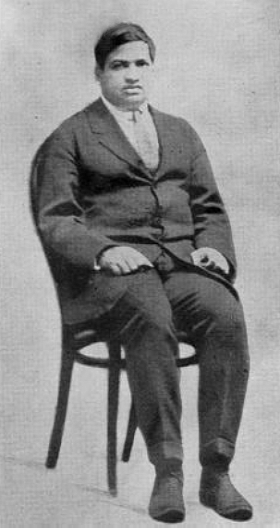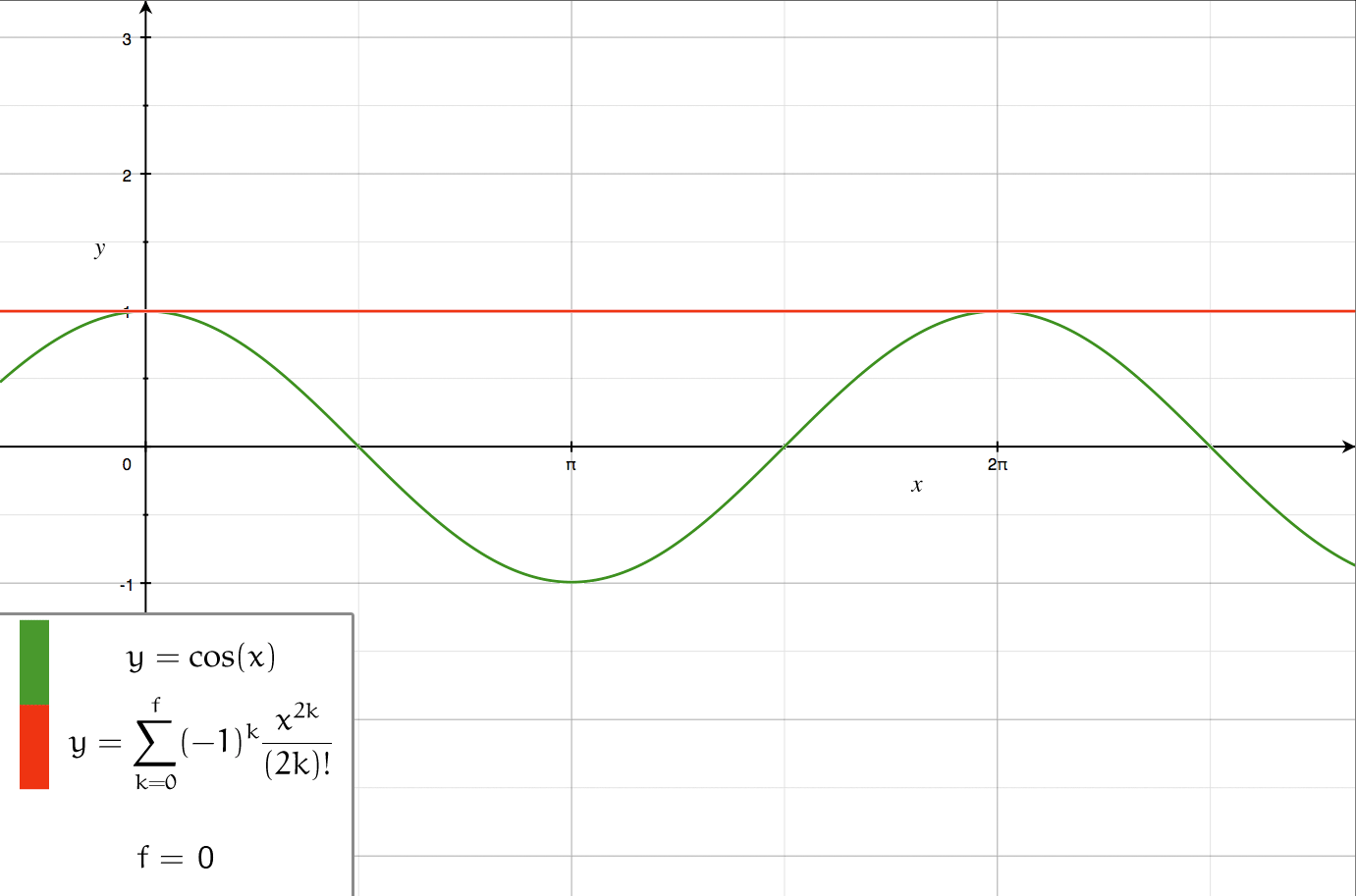|
Gelfond Constant
In mathematics, the exponential of pi , also called Gelfond's constant, is the real number raised to the power . Its decimal expansion is given by: :' = ... Like both and , this constant is both irrational and transcendental. This follows from the Gelfond–Schneider theorem, which establishes to be transcendental, given that is algebraic and not equal to zero or one and is algebraic but not rational. We have e^\pi = (e^)^ = (-1)^,where is the imaginary unit. Since is algebraic but not rational, is transcendental. The numbers and are also known to be algebraically independent over the rational numbers, as demonstrated by Yuri Nesterenko. It is not known whether is a Liouville number. The constant was mentioned in Hilbert's seventh problem alongside the Gelfond–Schneider constant and the name "Gelfond's constant" stems from Soviet mathematician Alexander Gelfond. Occurrences The constant appears in relation to the volumes of hyperspheres: The volume of an ... [...More Info...] [...Related Items...] OR: [Wikipedia] [Google] [Baidu] |
Mathematics
Mathematics is a field of study that discovers and organizes methods, Mathematical theory, theories and theorems that are developed and Mathematical proof, proved for the needs of empirical sciences and mathematics itself. There are many areas of mathematics, which include number theory (the study of numbers), algebra (the study of formulas and related structures), geometry (the study of shapes and spaces that contain them), Mathematical analysis, analysis (the study of continuous changes), and set theory (presently used as a foundation for all mathematics). Mathematics involves the description and manipulation of mathematical object, abstract objects that consist of either abstraction (mathematics), abstractions from nature orin modern mathematicspurely abstract entities that are stipulated to have certain properties, called axioms. Mathematics uses pure reason to proof (mathematics), prove properties of objects, a ''proof'' consisting of a succession of applications of in ... [...More Info...] [...Related Items...] OR: [Wikipedia] [Google] [Baidu] |
N-sphere
In mathematics, an -sphere or hypersphere is an - dimensional generalization of the -dimensional circle and -dimensional sphere to any non-negative integer . The circle is considered 1-dimensional and the sphere 2-dimensional because a point within them has one and two degrees of freedom respectively. However, the typical embedding of the 1-dimensional circle is in 2-dimensional space, the 2-dimensional sphere is usually depicted embedded in 3-dimensional space, and a general -sphere is embedded in an -dimensional space. The term ''hyper''sphere is commonly used to distinguish spheres of dimension which are thus embedded in a space of dimension , which means that they cannot be easily visualized. The -sphere is the setting for -dimensional spherical geometry. Considered extrinsically, as a hypersurface embedded in -dimensional Euclidean space, an -sphere is the locus of points at equal distance (the ''radius'') from a given '' center'' point. Its interior, consisting of ... [...More Info...] [...Related Items...] OR: [Wikipedia] [Google] [Baidu] |
Trillion
''Trillion'' is a number with two distinct definitions: *1,000,000,000,000, i.e. one million 1,000,000, million, or (ten to the twelfth Exponentiation, power), as defined on the long and short scales, short scale. This is now the meaning in both American and British English. *Orders of magnitude (numbers)#1018, 1,000,000,000,000,000,000, i.e. (ten to the eighteenth power), as defined on the long and short scales, long scale. This is one million times larger than the short scale trillion. This is the historical meaning in English and the current use in many non-English-speaking countries where ''trillion'' and ''billion'' (ten to the twelfth power) maintain their long scale definitions. Usage Originally, the United Kingdom used the long scale trillion. However, since 1974, official UK statistics have used the short scale. Since the 1950s, the short scale has been increasingly used in technical writing and journalism, although the long scale definition still has some limited u ... [...More Info...] [...Related Items...] OR: [Wikipedia] [Google] [Baidu] |
Srinivasa Ramanujan
Srinivasa Ramanujan Aiyangar (22 December 188726 April 1920) was an Indian mathematician. Often regarded as one of the greatest mathematicians of all time, though he had almost no formal training in pure mathematics, he made substantial contributions to mathematical analysis, number theory, infinite series, and continued fractions, including solutions to mathematical problems then considered unsolvable. Ramanujan initially developed his own mathematical research in isolation. According to Hans Eysenck, "he tried to interest the leading professional mathematicians in his work, but failed for the most part. What he had to show them was too novel, too unfamiliar, and additionally presented in unusual ways; they could not be bothered". Seeking mathematicians who could better understand his work, in 1913 he began a mail correspondence with the English mathematician G. H. Hardy at the University of Cambridge, England. Recognising Ramanujan's work as extraordinary, Hardy arranged ... [...More Info...] [...Related Items...] OR: [Wikipedia] [Google] [Baidu] |
Martin Gardner
Martin Gardner (October 21, 1914May 22, 2010) was an American popular mathematics and popular science writer with interests also encompassing magic, scientific skepticism, micromagic, philosophy, religion, and literatureespecially the writings of Lewis Carroll, L. Frank Baum, and G. K. Chesterton.Martin (2010) He was a leading authority on Lewis Carroll; '' The Annotated Alice'', which incorporated the text of Carroll's two Alice books, was his most successful work and sold over a million copies.Martin Gardner obituary (2010) He had a lifelong interest in magic and illusion and in 1999, ''MAGIC'' magazine named him as one of the "10 ... [...More Info...] [...Related Items...] OR: [Wikipedia] [Google] [Baidu] |
Scientific American
''Scientific American'', informally abbreviated ''SciAm'' or sometimes ''SA'', is an American popular science magazine. Many scientists, including Albert Einstein and Nikola Tesla, have contributed articles to it, with more than 150 Nobel Prize-winners being featured since its inception. In print since 1845, it is the oldest continuously published magazine in the United States. ''Scientific American'' is owned by Springer Nature, which is a subsidiary of Holtzbrinck Publishing Group. History ''Scientific American'' was founded by inventor and publisher Rufus Porter (painter), Rufus Porter in 1845 as a four-page weekly newspaper. The first issue of the large-format New York City newspaper was released on August 28, 1845. Throughout its early years, much emphasis was placed on reports of what was going on at the United States Patent and Trademark Office, U.S. Patent Office. It also reported on a broad range of inventions including perpetual motion machines, an 1860 devi ... [...More Info...] [...Related Items...] OR: [Wikipedia] [Google] [Baidu] |
April Fools' Day
April Fools' Day or April Fool's Day (rarely called All Fools' Day) is an annual custom on the 1st of April consisting of practical jokes, hoaxes, and pranks. Jokesters often expose their actions by shouting "April Fool[s]!" at the recipient. Mass media can be involved with these pranks, which may be revealed as such the following day. The custom of setting aside a day for playing harmless pranks upon one's neighbor has been relatively common in the world historically. Origins Although many theories have been proposed throughout the years, the origin of April Fools' Day is not exactly known. A disputed association between 1 April and foolishness is in Geoffrey Chaucer's ''The Canterbury Tales'' (1392). In the "Nun's Priest's Tale", a vain cock, Chauntecleer, is tricked by a fox "Since March began, full thirty days and two," i.e. the 32nd day from 1 March, which is 1 April. However, it is not clear that Chaucer was referencing 1 April since the text of the "Nun's Priest's Tale" ... [...More Info...] [...Related Items...] OR: [Wikipedia] [Google] [Baidu] |
Charles Hermite
Charles Hermite () FRS FRSE MIAS (24 December 1822 – 14 January 1901) was a French mathematician who did research concerning number theory, quadratic forms, invariant theory, orthogonal polynomials, elliptic functions, and algebra. Hermite polynomials, Hermite interpolation, Hermite normal form, Hermitian operators, and cubic Hermite splines are named in his honor. One of his students was Henri Poincaré. He was the first to prove that '' e'', the base of natural logarithms, is a transcendental number. His methods were used later by Ferdinand von Lindemann to prove that is transcendental. Life Hermite was born in Dieuze, Moselle, on 24 December 1822, with a deformity in his right foot that would impair his gait throughout his life. He was the sixth of seven children of Ferdinand Hermite and his wife, Madeleine née Lallemand. Ferdinand worked in the drapery business of Madeleine's family while also pursuing a career as an artist. The drapery business relocated to Nan ... [...More Info...] [...Related Items...] OR: [Wikipedia] [Google] [Baidu] |
Heegner Number
In number theory Number theory is a branch of pure mathematics devoted primarily to the study of the integers and arithmetic functions. Number theorists study prime numbers as well as the properties of mathematical objects constructed from integers (for example ..., a Heegner number (as termed by Conway and Guy) is a square-free positive integer ''d'' such that the imaginary quadratic field \Q\left sqrt\right/math> has class number 1. Equivalently, the ring of algebraic integers of \Q\left sqrt\right/math> has unique factorization. The determination of such numbers is a special case of the class number problem, and they underlie several striking results in number theory. According to the (Baker–) Stark–Heegner theorem there are precisely nine Heegner numbers: This result was conjectured by Gauss and proved up to minor flaws by Kurt Heegner in 1952. Alan Baker and Harold Stark independently proved the result in 1966, and Stark further indicated that the gap in ... [...More Info...] [...Related Items...] OR: [Wikipedia] [Google] [Baidu] |
Ramanujan's Constant
In number theory, a Heegner number (as termed by Conway and Guy) is a square-free positive integer ''d'' such that the imaginary quadratic field \Q\left sqrt\right/math> has class number 1. Equivalently, the ring of algebraic integers of \Q\left sqrt\right/math> has unique factorization. The determination of such numbers is a special case of the class number problem, and they underlie several striking results in number theory. According to the (Baker–) Stark–Heegner theorem there are precisely nine Heegner numbers: This result was conjectured by Gauss and proved up to minor flaws by Kurt Heegner in 1952. Alan Baker and Harold Stark independently proved the result in 1966, and Stark further indicated that the gap in Heegner's proof was minor. Euler's prime-generating polynomial Euler's prime-generating polynomial n^2 + n + 41, which gives (distinct) primes for ''n'' = 0, ..., 39, is related to the Heegner number 163 = 4 · 41 ... [...More Info...] [...Related Items...] OR: [Wikipedia] [Google] [Baidu] |
Series Expansion
In mathematics, a series expansion is a technique that expresses a Function (mathematics), function as an infinite sum, or Series (mathematics), series, of simpler functions. It is a method for calculating a Function (mathematics), function that cannot be expressed by just elementary operators (addition, subtraction, multiplication and division). The resulting so-called ''Series (mathematics), series'' often can be limited to a finite number of terms, thus yielding an approximation of the function. The fewer terms of the sequence are used, the simpler this approximation will be. Often, the resulting inaccuracy (i.e., the partial sum of the omitted terms) can be described by an equation involving Big O notation (see also asymptotic expansion). The series expansion on an open interval will also be an approximation for non-analytic functions. Types of series expansions There are several kinds of series expansions, listed below. Taylor series A ''Taylor series'' is a power ser ... [...More Info...] [...Related Items...] OR: [Wikipedia] [Google] [Baidu] |






